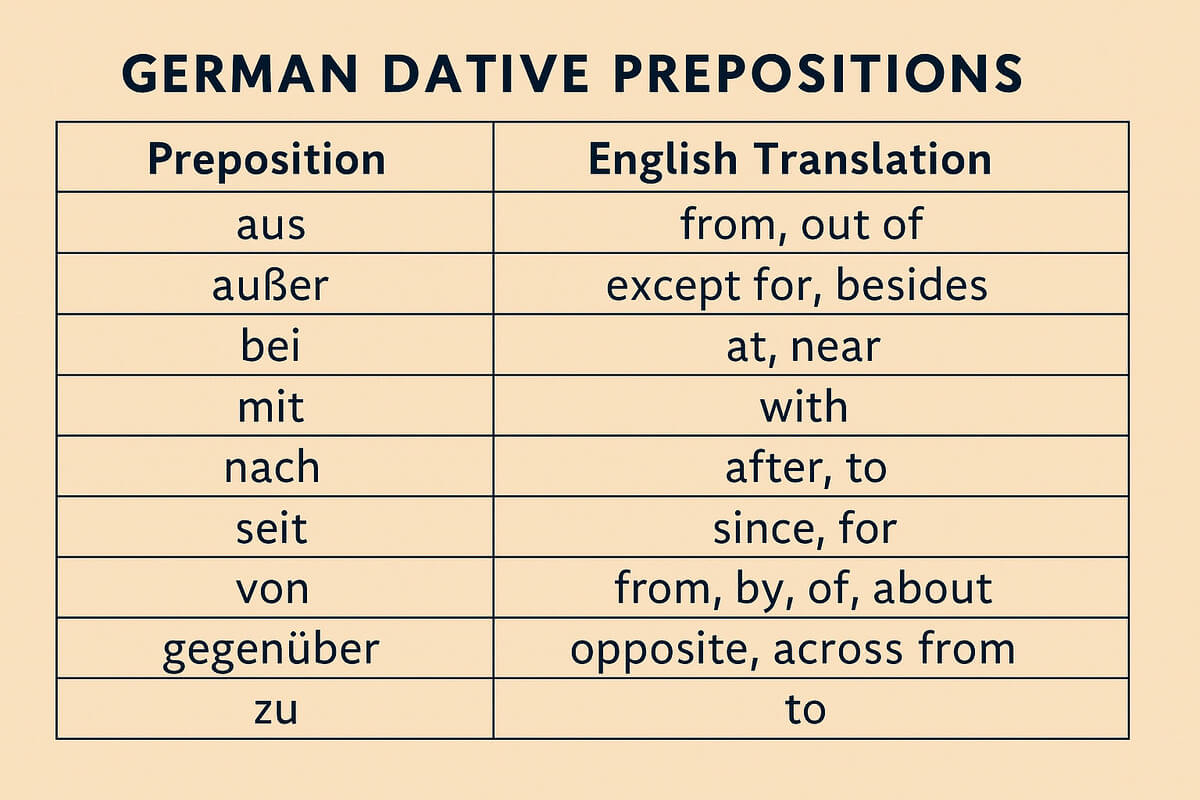Table of Contents
Mastering dative prepositions is a crucial step in becoming proficient in German grammar. These prepositions always need the dative case, influencing the articles, adjectives, and nouns that follow them.
Using dative prepositions correctly is essential for constructing accurate sentences and avoiding common mistakes related to German cases. By the end of this guide, you'll have a solid understanding of when and how to use each dative preposition.
Complete List of German Dative Prepositions
There are nine prepositions in German that always take the dative case. These are sometimes referred to as "dedicated dative prepositions" because they exclusively work with the dative case.
| Preposition | Example Sentence in German | English Translation |
|---|---|---|
| aus (from, out of) | Sie kommt aus dem Haus. | She is coming from the house. |
| außer (except for, besides) | Außer dir ist niemand gekommen. | Nobody came except for you. |
| bei (at, near) | Tina ist im Haus ihrer Tante. | Tina is at her aunt's house. |
| mit (with) | Wir fahren mit dem Auto. | We are traveling by car. |
| nach (after, to) | Nach der Arbeit gehe ich nach Hause. | After work, I go home. |
| seit (since, for) | Ich lerne seit einem Jahr Deutsch. | I have been learning German for a year. |
| von (from, by, of, about) | Das Buch ist von einem bekannten Autor. | The book is by a well-known author. |
| zu (to) | Wir gehen zu dem Konzert. | We are going to the concert. |
| gegenüber (opposite, across from) | Die Bank ist gegenüber dem Supermarkt. | The bank is opposite the supermarket. |
Note:
The examples above show how these prepositions govern the dative case (e.g., dem Haus, einem Jahr). Pay close attention to the articles and endings.
Understanding the Dative Case
Before diving deeper into dative prepositions, it's important to understand what the dative case is and how it transforms German nouns, articles, and pronouns.
What is the Dative Case?
The dative case (Dativ) typically indicates the indirect object in a sentence — the person or thing that receives the benefit or harm of an action.
Example:
Ich gebe dem Mann das Buch. (I give the book to the man.)
Here, "dem Mann" is in the dative case because he is the recipient of the book.
Dative Case Transformations
When a noun is in the dative case, its accompanying articles and adjectives must change accordingly:
| Gender | Nominative | Dative |
|---|---|---|
| Masculine | der Mann | dem Mann |
| Feminine | die Frau | der Frau |
| Neuter | das Kind | dem Kind |
| Plural | die Kinder | den Kindern |
Important Note:
Plural nouns in the dative case receive an additional -n unless they already end in -n or -s (for instance, mit den Kindern but mit den Autos).
Dative Personal Pronouns
Personal pronouns also change when they're in the dative case:
| Nominative | Dative | Example with "mit" |
|---|---|---|
| ich (I) | mir | Er spricht mit mir. (He speaks with me.) |
| du (you, informal) | dir | Ich gehe mit dir. (I go with you.) |
| er (he) | ihm | Sie tanzt mit ihm. (She dances with him.) |
| sie (she) | ihr | Wir sprechen mit ihr. (We speak with her.) |
| es (it) | ihm | Ich bin zufrieden mit ihm. (I'm satisfied with it.) |
| wir (we) | uns | Er kommt mit uns. (He comes with us.) |
| ihr (you, plural informal) | euch | Sie fährt mit euch. (She drives with you all.) |
| sie (they) | ihnen | Ich arbeite mit ihnen. (I work with them.) |
| Sie (you, formal) | Ihnen | Wir tanzen mit Ihnen. (We dance with you.) |
Detailed Explanation of Each Dative Preposition
Let's explore each dative preposition in detail with multiple examples to understand their various meanings and uses.
Aus (from, out of)
Meaning:
Examples:
Außer (except for, besides)
Meaning:
Examples:
Bei (at, near)
Meaning:
Examples:
Mit (with, by means of)
Meaning:
Examples:
Memory Techniques for Dative Prepositions
Memorizing the nine dative prepositions can be challenging at first. Here are some effective techniques to help you remember them:
1. The "Good King Wenceslas" Method
You can sing the dative prepositions to the tune of the first two lines of the Christmas carol Good King Wenceslas:
aus, außer, bei, mit, nach, seit, von, zu, gegenüber
2. The "Blue Danube" Method
Alternatively, you can sing the first eight prepositions to the tune of Strauss' Blue Danube:
aus - außer - bei - mit, nach - seit, von - zu
(And remember gegenüber separately.)
3. The Acronym Method
Create a sentence or phrase where each word starts with the first letter of each preposition:
All Austrian Boys Must Never Stop Valuing Zucchini Growth
(aus, außer, bei, mit, nach, seit, von, zu, gegenüber)
4. The Recipe Association Method
Another mnemonic shared by German learners is to imagine ingredients for a recipe:
Dative Prepositional Contractions
In German, certain dative prepositions combine with definite articles to form contractions:
| Preposition + Article | Contraction | Example |
|---|---|---|
| zu + dem | zum | Ich gehe zum Bahnhof. (I'm going to the train station.) |
| zu + der | zur | Wir fahren zur Schule. (We're driving to the school.) |
| von + dem | vom | Das Buch ist vom Professor. (The book is from the professor.) |
| bei + dem | beim | Wir treffen uns beim Supermarkt. (We're meeting at the supermarket.) |
| an + dem | am | Das Bild hängt am Fenster. (The picture hangs at the window.) |
| in + dem | im | Das Buch liegt im Regal. (The book is on the shelf.) |
Note:
The last two contractions (am, im) are for two-way prepositions when used with the dative case. While not exclusively dative prepositions, they’re commonly encountered in dative contexts.
Common Mistakes to Avoid
When working with dative prepositions, be mindful of these frequent errors:
1. Forgetting to Change the Article
Incorrect: Ich gehe mit die Freundin ins Kino.
Correct: Ich gehe mit der Freundin ins Kino.
Feminine die becomes der in the dative case.
2. Missing the Plural -n Ending
Incorrect: Er spricht mit den Kinder.
Correct: Er spricht mit den Kindern.
Add -n to plural nouns in the dative if they don't already end in -n or -s.
3. Confusing "nach" and "zu" for Destinations
Incorrect: Ich fahre nach dem Supermarkt.
Correct: Ich fahre zu dem Supermarkt. (zum Supermarkt)
Nach is for countries/cities without articles; zu is used for specific locations.
4. Using the Wrong Word Order with "gegenüber"
Semi-correct but awkward: Gegenüber mir sitzt ein Mann.
Better: Mir gegenüber sitzt ein Mann. (A man is sitting opposite me.)
Though both are possible, Mir gegenüber is more natural.
Practice Examples with Dative Prepositions
Below are some everyday examples. Notice how each dative preposition governs the dative noun or pronoun:
1. Daily Routine
Ich stehe jeden Morgen um sechs Uhr auf und fahre mit dem Bus zur Universität. Nach dem Unterricht treffe ich mich oft mit meinen Freunden bei einem Café gegenüber der Bibliothek.
I get up at six every morning and take the bus to the university. After class, I often meet with my friends at a café opposite the library.
2. Travel
Letzten Sommer bin ich mit meiner Familie nach Italien gefahren. Wir sind aus Deutschland mit dem Auto gereist und haben bei Freunden in einem kleinen Dorf gewohnt. Seit dieser Reise träume ich davon, nach Italien zurückzukehren.
Last summer I went to Italy with my family. We traveled from Germany by car and stayed with friends in a small village. Since this trip, I dream of returning to Italy.
3. At Work
Ich arbeite seit drei Jahren bei einer internationalen Firma. Jeden Tag gehe ich zu meinem Büro, das gegenüber dem Hauptbahnhof liegt. Ich spreche oft mit Kunden aus verschiedenen Ländern und lerne viel von meinen Kollegen.
I have been working at an international company for three years. Every day I go to my office, which is located opposite the main train station. I often speak with customers from different countries and learn a lot from my colleagues.
4. Describing a Gift
Dieses Schmuckstück ist von meiner Großmutter. Es ist aus Gold und sehr wertvoll. Nach ihrem Tod hat sie es mir hinterlassen. Außer diesem Schmuckstück habe ich nicht viel von ihr.
This piece of jewelry is from my grandmother. It is made of gold and very valuable. After her death, she left it to me. Apart from this jewelry, I don't have much from her.
Free Quizzes to Test Your Knowledge
Ready to test your understanding of German dative prepositions? Try our free quizzes to reinforce what you've learned.
Dative Prepositions Quiz
Test your knowledge of all nine dative prepositions with example sentences and multiple-choice questions.
Take the QuizDative vs. Accusative Prepositions
Challenge yourself to distinguish between dative and accusative prepositions in various contexts.
Take the QuizFrequently Asked Questions
How do I remember all the German dative prepositions?
There are several mnemonic techniques you can use, such as singing them to the tune of Good King Wenceslas or using an acronym. Regular practice with example sentences will also help cement them in your memory.
What is the difference between dative and accusative prepositions in German?
Dative prepositions always take the dative case. Accusative prepositions always need the accusative case. There are also two-way prepositions that can take either case depending on whether they indicate location (dative) or movement (accusative).
Why do some prepositions like "nach" not use articles for countries?
In German, most country names are neuter and used without articles. When referring to traveling to these countries, nach is used without an article (e.g., "nach Deutschland"). For countries used with an article, in + accusative is used (e.g., "in die Schweiz").
Are there exceptions to the dative preposition rules?
The nine dedicated dative prepositions always require the dative. However, some traditionally genitive prepositions like während, or wegen are sometimes used in the spoken language with the dative.
How do I know when to use contractions like "zum" vs. "zu dem"?
Using contractions (zum, zur, vom, beim) is standard in modern German. The non-contracted forms are generally used only for emphasis or clarity. In everyday conversation, you should use contractions.
Where can I find more resources on German grammar cases?
Check out our comprehensive guide to the German dative case, as well as our articles on German prepositions and two-way prepositions. Practice with quizzes and exercises to solidify your knowledge.
Key Takeaways
Ready to Master German Grammar?
Take your German skills to the next level with personalized lessons from an expert tutor.
Book a LessonSee what our students are saying on our testimonials page.

